|
Lighting the Way to
Safety
by Bob Brooke
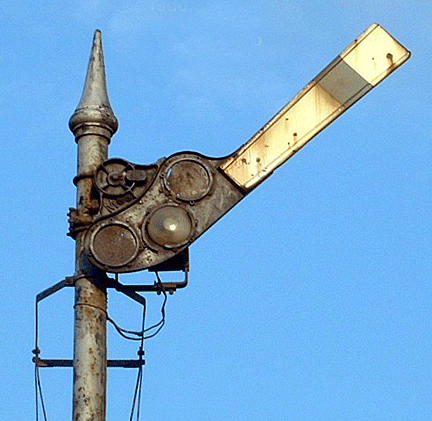 Over
the years, the operations of railroads became more and more complex. One
train traveling along a short route was one thing, but multiple trains
began traveling on the same set of tracks presented potentially
dangerous situations. Locomotive engineers and trainmen needed to
communicate with each other. Before the automated technology and signals
used today, they had to rely on visual signals. During the daylight
hours,, this wasn’t much of a problem, but communicating at night was
impossible without light. And thus the railroad lantern was born. Over
the years, the operations of railroads became more and more complex. One
train traveling along a short route was one thing, but multiple trains
began traveling on the same set of tracks presented potentially
dangerous situations. Locomotive engineers and trainmen needed to
communicate with each other. Before the automated technology and signals
used today, they had to rely on visual signals. During the daylight
hours,, this wasn’t much of a problem, but communicating at night was
impossible without light. And thus the railroad lantern was born.
In order to safely operate a train yard, railroad workers had to have a
way of communicating with each other and train engineers. During the
days of steam locomotives, the noise and distance involved with train
operations ruled out speaking or yelling, especially since common radio
devices weren't yet available. Any device they used would also have had
to be portable, since those working on the line were constantly on the
move. While flags and semaphores worked during the day, they weren’t
effective at night. In order to communicate after dark, railroad workers
depended on kerosene lanterns.
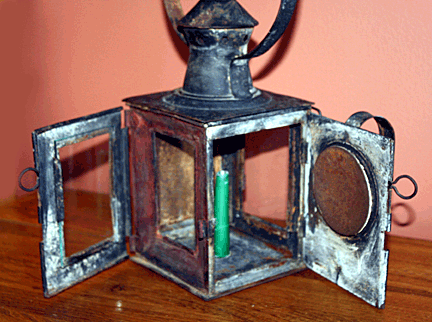
Railroad workers used lanterns as a hand signaling device, swinging them
in various ways to send a message such as to stop or slow the breaks.
Kerosene lanterns became the most effective way to communicate in the
dark.
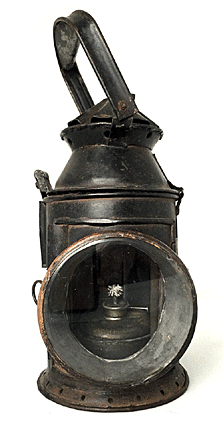 Before
the invention of electricity and computers that gave rise to advanced
forms of railroad signaling technology, trains required a great deal of
coordination and manpower to communicate with one another along the
railroad line. Before
the invention of electricity and computers that gave rise to advanced
forms of railroad signaling technology, trains required a great deal of
coordination and manpower to communicate with one another along the
railroad line.
Additionally, lanterns could double as a heat source to stay warm on
chilly nights.
During the Civil War, improvements to the rail transportation system
made it practical to ship lanterns from state to state. It was also
during the war that makers began using metal stamping machines to draw
and press metal, making the lantern manufacturing process more
efficient.
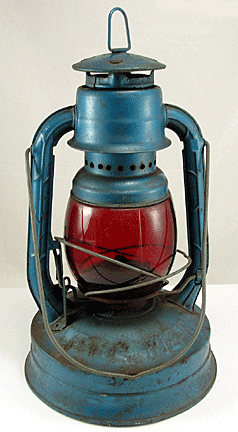 The
first company to make kerosene lanterns was the R. E. Dietz Company. In
1856, kerosene began to be distilled in quantity from coal, giving
Robert Dietz the opportunity to apply for and receive a patent for a
kerosene burner. The
first company to make kerosene lanterns was the R. E. Dietz Company. In
1856, kerosene began to be distilled in quantity from coal, giving
Robert Dietz the opportunity to apply for and receive a patent for a
kerosene burner.
During the 1860s, Civil War contracts, Dietz’s hard work, the growth of
railroads, and westward expansion made his lamp business a huge success.
Fire destroyed the 10-year-old factory in June 1897 and C T Ham offered
to sell out to Dietz for $190,000. Instead, in February 1898, the board
of directors secured controlling interest in the Steam Guage & Lantern
Comapany of Syracuse, New York. The New York city factory was back in
operation later that same year. In 1915 the R.E. Dietz Company purchased
the equipment from the closed C. T. Ham Manufacturing Company.
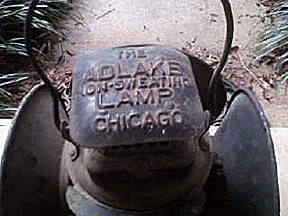 On
October 21, 1874, John Adams, a salesman from New York, and William
Westlake, a tinsmith who invented the removable globe lantern, joined
their two companies to create the Adams and Westlake Company, commonly
known as Adlake, located in Chicago, Illinois. The new company became
the most successful railroad lantern company ever. Even though it made
standard railroad lanterns as early as 1857, it didn’t begin to
manufacture switching lanterns until the 1890s. Adlake Manufacturing
moved from Chicago to Elkhart, Indiana, in 1927. It was the last of many
companies to manufacture kerosene railroad lanterns and ended up
absorbing its competition in the 1960s as lantern sales plummeted .
Today, it makes lanterns for display and train show use. On
October 21, 1874, John Adams, a salesman from New York, and William
Westlake, a tinsmith who invented the removable globe lantern, joined
their two companies to create the Adams and Westlake Company, commonly
known as Adlake, located in Chicago, Illinois. The new company became
the most successful railroad lantern company ever. Even though it made
standard railroad lanterns as early as 1857, it didn’t begin to
manufacture switching lanterns until the 1890s. Adlake Manufacturing
moved from Chicago to Elkhart, Indiana, in 1927. It was the last of many
companies to manufacture kerosene railroad lanterns and ended up
absorbing its competition in the 1960s as lantern sales plummeted .
Today, it makes lanterns for display and train show use.
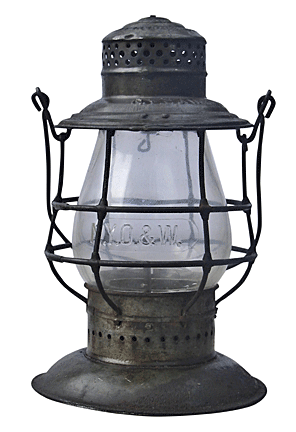 Generally,
the oldest version of Adlake lanterns on the antiques market today are
those known as "The Adams." The company produced them from the 1890s
through around 1913 when its replacement, the "Reliable" model, came on
the market. All of Adlakes lanterns were extremely heavy duty and well
made. Today, Adlake switching lanterns in excellent condition sell for
$100-300 on eBay. Generally,
the oldest version of Adlake lanterns on the antiques market today are
those known as "The Adams." The company produced them from the 1890s
through around 1913 when its replacement, the "Reliable" model, came on
the market. All of Adlakes lanterns were extremely heavy duty and well
made. Today, Adlake switching lanterns in excellent condition sell for
$100-300 on eBay.
The Adlake "The Adams" models are the oldest version of the Adlake
Railroad lanterns that can still be somewhat commonly found on the used
market today. They were produced from approximately the 1890s through
around 1913 when its replacement, the "Reliable" models, were
introduced. Some sources indicate that they may have been produced as
late as WW1, which would indicate around 1917. Like the Reliable, they
were produced in numerous variations, including twist off bottom pots
and lift out insert pots.
The cage varied as well, with some models have a standard wire cage and
others having a steel slat cage. Bell Bottom and Wire Bottoms were also
options. The lanterns were extremely heavy duty and well made and it
solidified Adlake as a railroad lantern maker, allowing it to introduced
much improved models later on that would make Adlake the largest and
most produced railroad lanterns ever. The Adams lanterns take the
standard No. 39 5-3/8" globes.
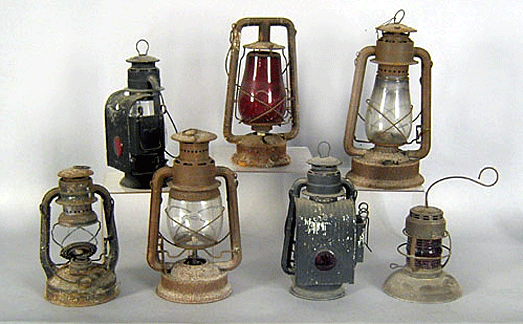
For those spellbound by the history of railroads, lanterns have become a
collector item worth scavenging for. The classic image of a man hanging
off the back of a train with a lantern swaying back and forth is
regularly associated with bygone America. Most lanterns had a black
metal cage with glass insets around the interior light source, but there
are many different lantern styles that emerged from the old railroad
times. The five general lantern categories collectors usually identify
include inspector, fixed globe, tall globe, short globe, and
presentation or conductor lanterns.
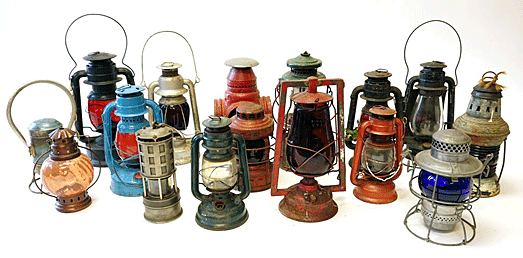
The railroad industry in North American no longer uses railroad kerosene
lanterns except in rare cases, however lanterns like these were in
common use through the 1960s and in sporadic use as late as the 1970s
and 1980s. Adlake was the last manufacture of kerosene railroad lanterns
and ended up absorbing the remaining lantern manufactures in the 1960s
as lantern sales plummeted and overall demand did not justify multiple
companies.
To learn more about railroad signal lanterns and
see how trainmen used them to communicate various signals, go to
JeffPo's Railroad Lantern Page.
< Back
to Collectibles Archives
Next Article > |
